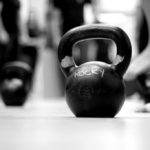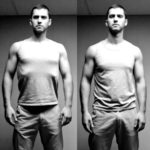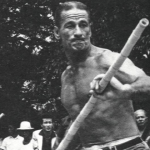I am a sports medicine physician from Kaunas, Lithuania. My passion is human movement and helping people move safely and properly. In addition to corrective exercises I use manipulative therapy (a method of treatment for restrictions in soft tissues and joints) by means of mobilization and manipulation as well as systemic dry needling (where acupuncture needles are used in specific places in the body to stimulate homeostasis) and biopuncture (combining principles of neural therapy and biological medicine). I participated as the team physician for Lithuania in five summer and four winter Olympic games and was the chief medical officer for the Lithuanian Olympic team at the 2000 games in Sydney. I am not yet initiated as part of the StrongFirst tribe of instructors but I have attended Second Wind and Strong EnduranceTM and I am keen to keep learning. I believe the kettlebell is as versatile of a training tool as the acupuncture needle is in medical practice.
In a present situation with COVID-19, I feel strongly that health professionals must be proactive. A virus is a professional intruder, so our defense systems must be in superior shape. We know that the virus enters our system through epithelial tissues of the upper breathing airways. Among other functions, these tissues protect against pathogens so their proper function is of paramount importance. Let’s keep the gates closed, well protected, and functioning at an optimal level while we keep our quality of health at a respectable level.
Please remember that the “battle for oxygen” unites all the adaptive reactions to negative stimuli in our body. So cold, heat, hypoxic/hypercapnic training in addition to a smart exercise plan must be used in combination to contribute to our quality of health.
Physiological Foundation
Ciliated columnar epithelia line the nasal cavities, extending to the nasopharynx. These cilia beat up to 1000 times per minute and transport a superficial layer of mucus towards the nasopharynx to be swallowed or expelled. Mucus provides a sticking surface and contains a variety of antimicrobial proteins to neutralize invaders. The Strelnikova breathing method I’m about to explain will improve this ability to combat the pathogen.
The nose acts as a valve and provides a resistance to breathing that is twice that of the open mouth. This means more turbulence of the air flow during intense nasal breathing, resulting in more information for immune cells via the mucosal surface receptors. This is why Pavel’s Second Wind seminar recommends nose breathing as preferable and optimal during moderate intensity exercises.
The Strelnikova Breathing Method
There are many systems of training one’s breath, but given our need for immediate action, Alexandra Strelnikova’s method is the perfect fit. It was originally created to help singers restore their voice, but later it proved helpful for those with respiratory illnesses like asthma, tuberculosis, and chronic bronchitis. It is not well known outside of Russia, but perfectly suitable for our needs. Be sure when practicing this breathing you are in a well ventilated room, or outside but not when the temperature is below freezing.
Strelnikova’s method energizes the body, so ideally you should do this in the morning. You may do second time in the evening but do it at least two to three hours before going to bed. In my case I supplement this method with diaphragmatic breathing techniques in the evening.
The Technique:
- Only breathe in through the nose. You may breathe out through the mouth.
- The inhalation must be done sharply and powerfully. The exhalation just happens. Your whole attention is on inhaling powerfully through the nose.
- Synchronize the body movement with the inhalation.
The Progression:
- Start by doing 16 breaths with each of the three body movements (as showed in the video) for one week.
- Add 16 more breaths in each position after the first week.
- Gradually progress until you perform three series of 32 breaths in each position for a total of 96 breaths in each position.
Be sure to take some rest between the series and not hurry. Become aware of how every breath constricts the breathing airways, increasing the air flow resistance. Because you are focusing on the inhale and the exhale is just happening on its own, the carbon dioxide level in the blood will be normalized and you will not hyperventilate.
Even though this is a minimalist version remember that the body thrives on variability, so you can break this approach up into two methods.
Method #1: Do exercise #1 32 times for three sets, then repeat with exercises #2 and #3 32 times each.
Method #2: Do exercise #1 32 times, the same for exercises #2 and #3 and then repeat that whole sequence three times.
So in both methods the total number of inhalations is 96, but you have added a variability factor.
As you improve and move through the progression I’ve detailed for you above, you can try this more advanced modification: imagine that the inhale comes in through the nose and goes straight into your brain. This technique is very powerful, be careful to not overdo it.
Additional Tips and Resources
A strong immune system is first on the list for optimal health (STRONG FIRST!) so here are some recommendations to achieve that.
- Do not rely on food supplementation. The human body is incredibly complex and we are all different and unique creatures. In the case you are a person who needs supplements be sure your supplementation program is fine-tuned and tailored to you specifically.
- Avoid fast food. It can develop hyperglycemia (high blood glucose) which has a negative impact on the immune system and has been linked with higher death rates at intensive care units.
- Be diligent about your oral health. It’s the dirtiest place on the human body and its problems closely mirror your overall health. Also, if healthy it may act as a gate against infection. Flossing is a must!
- Bioactive proteins lysozyme and lactoferrin in the saliva are our first line of defense against toxins. Studies have shown an age-related decrease in saliva production making oral health essential to overall health.
Pulmonary surfactant is a delicate membrane composed of lipids and proteins. Its main function is to optimize the surface tension at the air/liquid interface in the lungs. Our body produces surfactant by using fatty acids and cholesterol, so a reasonable amount of animal fats in the daily diet is advisable.
Contraindications
Those with complicated cardiovascular conditions should be aware that activation of the drainage function, microcirculation in upper respiratory airways, reflex activation of the lower airways, and changes in blood pressure may destabilize the fragile balance in their condition.
If you are under the care of an oncologist please be aware that no studies on this subject matter exist to my knowledge so I would advise you speak with your oncologist and/or likely wait for remission before starting this protocol.
In patients with acute infections there is the possibility of dissemination of infectious agents when the immune system’s responses are inadequate.
STAY HEALTHY AND BE STRONG.






Thank you for this article. Does the inhalation occur when the fingers are clenching or extending? Or does it matter?
Scott
The logic of the method is to increase resistance for the inhalation phase of breathing cycle, so you will clench your fingers during inhale, when doing first exercise, you will powerfully extend during the second one, fingers relaxed during the third (body is bent, so inhalation already restricted), fourth exercise you must clench, when turning again. So it depends, but the answer is- Yes, it is important. regards Dalius
Thank you for this explanation. I also wonder if on the sharp inhale does the stomach extend or contract? I know most breathing exercises it expands on inhale but not sure on this one.
just concentrate on sharp inhale, because in Strelnikova breathing style it is just not enough time for anything else. And so it is simple-do it! Dalius
Dr. Barkauskas,
Do you do consulting online? Is there a way to contact you, or do you have a webiste/blog?
Thanks!
unsurprisingly face-to-face consultation is the best. But our world and our life rarely are in a situation of close to perfect balance. So You may contact me on Messenger and we will try to find optimal way for problem solving. Please let me know if it is not an option or something goes awry. Regards Dalius
Thank you!
We appreciate so much.
Wonderful article. Thanks for sharing. I love learning about breathing and how the holistic health benefits of breathing practices.
I was about to fall asleep and I found this interesting article.
Thank you, Dr. Barkauskas.
I will try it tomorrow.
Power to you!
Morning is the best as the first session time. I am sure you will be amazed by effect-no need for coffee! Though you may enjoy your cup afterwards.
Dalius
hello Dr. Barkauskas
Very nice article, thank you so much. I have two questions.
1) What about the other exercise in this method?
2) What would you recommend as a set of breathing exercise for the evening as we get closer to bed time?
Again, thank you very much for this information.
Chris
Hi, it is easier to answer the second question . So
as you know our autonomic nervous system starts switching into parasympathetic state from already 5-6 PM and therefore I am an advocate for morning training sessions. A response is even a bit more complex, because of interaction of dorsal plus ventral parts of a vagal nerve. So again the answer as you see involves many why’s first of all. But to make it simple-do diaphragmatic (lower diaphragmatic to be precise-inhale is felt below the belly button) breathing. During breathing diaphragmatic excursions will stimulate gentle sliding motions of our internal organs and so more balancing stimuli on dorsal vagus. So evening time -lower diaphragmatic breathing.
Now about your first question-do not hurry with progression! Start the program and you will see if you still need all the method. Of course you may find some info in the almighty Internet in a second, but if you think that my face and action (maybe some comments) are needed on the video clip, then please let me know. Dalius
At the moment for the purpose of recovering from this virus, the 4 exercises is already a discomfort. Once I can complete the whole 96×4 without discomfort I’ll look into the rest of it.
So the evenings do my box breathing and/or other diaphragm work. But reminder to myself to keep this light and pleasant so as to promote relaxation.
Thank you so much.
Chris
err – 3×32=96… not 4×96(that would be absurd)
If you do 4 exercises, each as recommended 3 series 32 times, it means 4 exercises 96 times each (-:
But please remember, that sometimes it is recommended to step back and do just 16 times each exercises once, but with good technique, feeling, concentration. Because in any case when we do recommended 3 series 32 times it happens more on autopilot mode, so to say. Regards Dalius